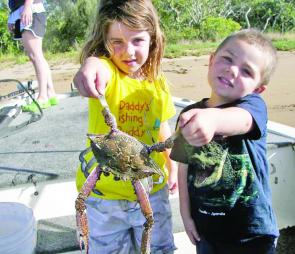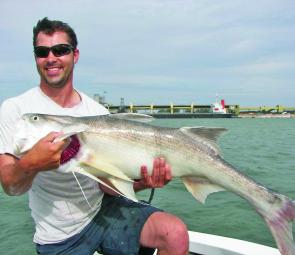The mouth of the Brisbane River has seen many changes over the last 20 years or so. Not only has the land mass been structured and sculptured to cater for the increasing demand for waterfront industries, but so to has the water quality changed creating a a great sports fishing environment.
Once the domain of bream, whiting, flathead and jew, we are now seeing snapper and threadfin becoming the dominant species. This has all happened in a very short period of time so the future looks very rosy for river anglers.
I never thought I would be saying this but now anglers can actually target these huge threadfin salmon with relative consistency. I know a few anglers that consistently catch these big critters with live baits in a few spots throughout the length of the river wherever the prawns school, but lately, experienced artificial users are targeting schools of salmon with great success.
I never thought I would be talking about schools of threadfin around the mouth of the river but they are there and they are in good numbers. Flats adjacent to deep water from the Gateway Bridge to the mouth of the river are the areas where the salmon are holding. They are feeding on whiting and prawns that move into the shallows with the making tide.
Anglers are targeting them the same way as anglers target then in North Queensland. Look out for them along shallow flats adjacent to creek mouths on the run in tide. The threadies sit in ambush for whiting, mullet and prawns to move out of the deep water onto the tidal flats to feed. We target the edge of the flats where it meets the deeper drop-offs. Most fish are holding in around 8-7ft of water.
I recently spoke to good mate Dave Young about a trip he did with Harry Watson and river regular Liam Fitspatric. The trio had a great morning fishing the incoming tide starting around the tidal flats at the mouth of the river and hooking seven threadies and landing two. The boys then moved upstream towards the Gateway fishing numerous shipping docks in search of snapper with great results.
From experience I’ve notices it’s not a matter of hooking them (they do that themselves) it’s a matter of being able to stop them before they reach some form of structure. It’s not uncommon at the moment to hook up to four per session but landing them with artificial lures is tough on gear. These fish are strong and will empty spools in seconds, break lures and straighten jigs and trebels with ease. Even though we hook fish at times several hundred metres from any structure they still find there way home. The trick to landing these huge threadies is to lead them into deep water and fight them away from any structure. You will know when you’ve hooked one of these monsters because most of the time they will come to the surface and show you how big they are before trying to destroy your tackle.
The rods and reels I am using is the same gear that I use for barra fishing: Nories 6’10” 20lb rod with a low profile reel spooled with 11kg yamatoyo jigging braid and leader to match. Most anglers are still targeting these fish on spinning tackle which is great for the lure manufactures, but with a little practice, you can successfully fish with bait-casting gear with much greater control and fish fighting ability.
I have seen these fish hooked on just about everything that has been cast at them from vibration baits to plastics. The vibration bait has had better success rate due to their strength, while the plastics definitely hook heaps of fish. The jig hooks have a lot of improvement to be done so they don’t straighten under pressure. Trying to stop a rampaging threadfin heading towards structure is not fun when hooked up with jig head rigs.
Very little is known about why, when and how the Threadfin population called the Brisbane River home. The size of these fish is really something to marvel, please treat these breeding giants with the upmost respect because if there numbers and size keep increasing like they have done over the last few years we will have a world class fishery for threadies at our door step. Imagine anglers travelling to Brisbane to catch a world record threadfin salmon.
Pelagic species like tuna and mackerel have made their presence felt with some decent schools showing up around the shipping beacons that lead out of the Brisbane River. Floating out pilchards on wire traces seems to be the most popular rig but for the more adventurous anglers small chrome slugs vertically jigged is a fun and productive way to catch your quota.
Bream and flathead are around the river mouth in good numbers especially around the tidal flats in front of Boggy Creek and around the Boat Passage both sides of the bridge. These areas are also holding good numbers of whiting that can be caught on the making tides using worms and locally caught yabbies.
Crabs are around but patchy depending on the tidal flow at present. The Boat Passage and around the Gateway Bridge have produced some reasonable numbers of sand crabs with the odd mud crab thrown in the mix. The numbers have not been around like in previous years but the season is only young.
Snapper are around in good numbers if you can find the schools. On recent trips we have only been able to find small numbers of fish on the bite. The regular spots like Claras Rocks and the new reclaimed section at the mouth can be very patchy at best. Areas that have been holding good fish numbers is the new marina near the Gateway and the numerous shipping docks opposite Bulimba Creek. Deep rock ledges that run from Claras Rocks upstream to Bulimba Creek have had some good numbers but finding where they are holding along the ledges can be difficult at times.
Around the smaller bay islands there has been great catches of bream in the shallows along with a healthy population of squid. Snapper, sweetlips and the occasional coral trout are coming from the reefed ledges that rim most of the smaller bay islands.
Prawns have definitely started to move around South East Queensland. The river trawlers are working flat out catching their quotas but for most of us without a trawler parked in the back yard it’s the trusty cast net that catches the feeds. The prawns will only get better heading into the New Year so it’s a great time to pull the net out of storage and do any repairs from last season and be ready for the onslaught.
I hope everybody has a safe and rewarding Christmas season. Get out and enjoy what the great South East has on offer. I hope the fishing, crabbing, prawning and boating is kind to you and your family for 2008.
Reads: 15801


Harry Watson with a nice Threadfin caught on Tranzam.




